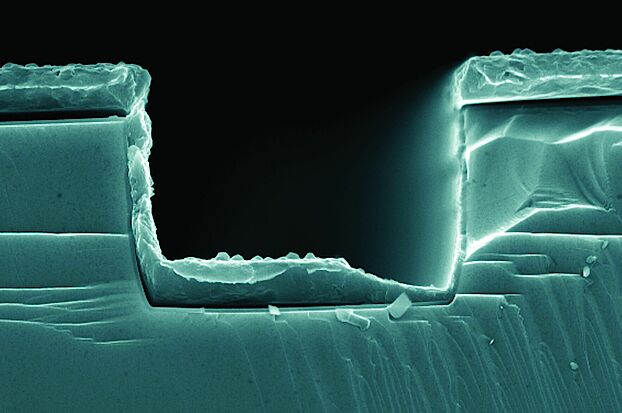/ Erfolgsgeschichten
Trenches reduce electrical resistance
Argovia project confirms theoretical approach
The SNI’s Nano-Argovia program supports applied research projects between academic research institutions in Northwestern Switzerland and industrial companies. In one such successful Argovia project, researchers from the CSEM in Muttenz, the Paul Scherrer Institute (PSI), the University of Basel, and the ABB Corporate Research Center investigated and optimized a novel type of transistor for power electronic applications. This transistor should also be suitable for high current densities and voltages, and could offer better properties than current, commercially available products.
Increasing demand for energy requires new electronics
We live in an age in which demand for energy is constantly growing, and it is intended that renewable energies will supply an increasing share of this overall demand. This presents new challenges in terms of practical application and for the scientific community. Electricity generated in offshore wind farms, for example, must be efficiently transported across long distances without significant losses.
Wind power and solar facilities produce alternating and direct currents of relatively low voltage. However, an alternating current of 50Hz and high voltage is required for the transport. “Special smart power electronics is required for such conversions that is also compatible with high current densities and voltages,” explains Dr. Holger Bartolf from the ABB Corporate Research Center, who initiated the project. With the ABB Corporate Research Center in the Canton of Aargau and experts from the CSEM, PSI, and the University of Basel, Northwestern Switzerland is perfectly equipped to play a major role in developing new technologies in this important area.
Silicon carbide could replace silicon
An effective power converter requires a number of digital switching operations. Each of these switches changes between an OFF state and an ON state. Ideally, no electric current (or only a very small leakage current) should flow through such a switch in the OFF state. When turned ON, however, lots of current flows with as little resistance as possible. It is also important that the switching operation is as fast as possible to keep the associated switching losses as low as possible. Today, metal-oxide semiconductor field effect transistors (MOSFETs/IGBTs) are primarily used as switches.
“Silicon-based semiconductors are currently dominating the market, but for scientists around the world, silicon carbide (SiC) seems to be an energy-efficient alternative,” explains Holger Bartolf. The properties of silicon carbide enable the design of smaller converters that are simpler to cool and which dissipate less electric power due to leakage currents when in the OFF state. However, silicon carbide switches have a higher resistance when in the ON state, thereby the conduction losses increase as compared to silicon semiconductors. These resistances are caused by defects in the interface layer between silicon carbide and silicon dioxide, in which an electronically conductive channel may form under certain conditions. Here, the silicon dioxide functions as an isolator between the operating gate electrode and the semiconductor.
Production is complex
Researchers from the “Nano SiC Trench MOSFET” Argovia project, led by Dr. Marc Schnieper from the CSEM in Muttenz, examined MOSFETs with microscopically small U-shaped trenches to solve the problem of lower electron mobility in the SiO2/SiC channel. “We have examined and optimized the manufacturing process for producing these specially structured semiconductors,” explains Marc Schnieper. These specially structured MOSFETs are much more complex and expensive to produce than planar MOSFETs. “It depends on the exact form and depth of the trenches, and their roughness is also key to their properties,” adds Professor Jens Gobrecht, whose laboratory at the PSI has being used for production.
Simulations have been confirmed
The scientists involved from the CSEM, the PSI, the University of Basel, and ABB also characterized the electronic switching behavior of these new transistors and compared their properties with those of planar MOSFETs. Theoretical simulations predicted a lower resistance, which was confirmed by the experiments performed last year. “Improving transistors is a highly significant challenge for us,” comments Professor Ernst Meyer from the University of Basel. “Around the world, more transistors are now being produced each day than grains of rice. Even the smallest improvements to their energy consumption will have a massive global impact.”

